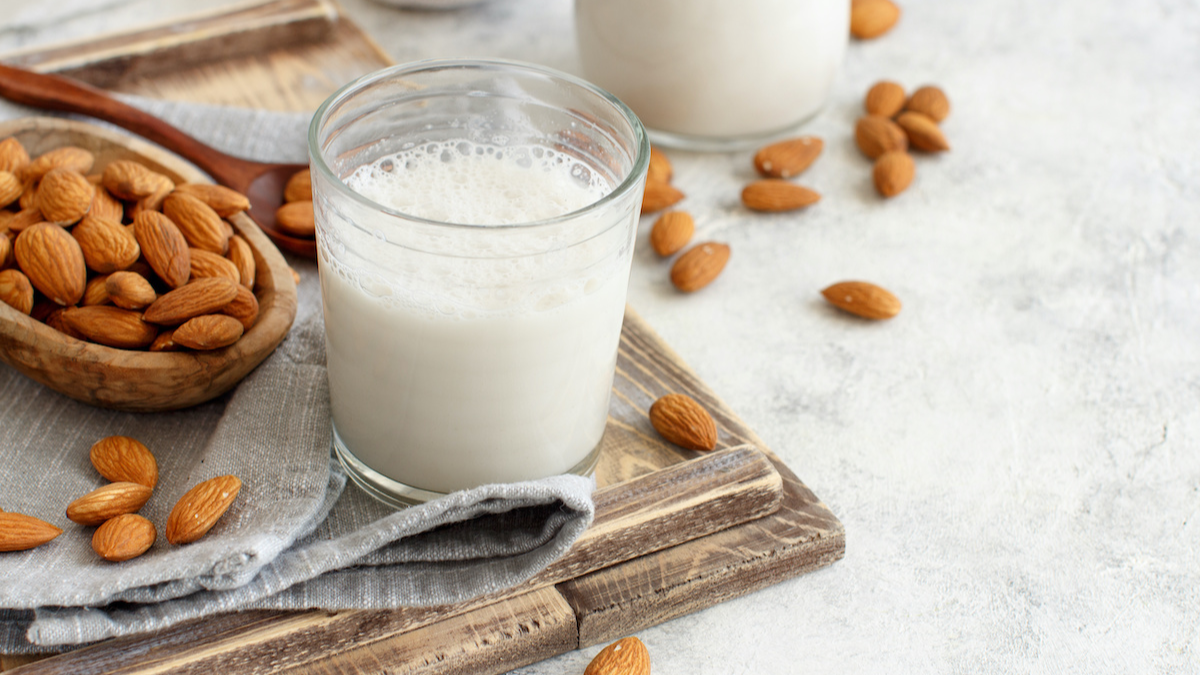If you work with dairy products, you probably already know milk cannot be left out of the refrigerator before it spoils. Cow’s milk may start to grow bacteria when left out at room temperature, which produces lactic acid and gives bad milk a sour flavor and odor.
Cow milk and almond milk do not have the same chemical characteristics. Almond milk doesn’t spoil as quickly as dairy milk because of these differences, but it’s vital to know how long almond milk may be stored before it degrades and harms your health.
Almond milk offers several health advantages. It has few calories, little sugar, and plenty of vitamins and minerals, including oleic acid and vitamin E, which cut cholesterol and lower the risk of heart disease. To make store-bought almond milk have a similar nutritional profile to cow’s milk, calcium, and vitamin D are frequently added. Knowing how to keep almond milk properly and detect spoiling is crucial if you routinely use it.
What is Almond Milk?
Almond milk is a plant-based beverage made from almonds with a watery texture and nutty flavor. It is low in saturated fat and free of lactose and cholesterol. Lactose-intolerant people and people who don’t eat dairy products, like vegans, frequently drink almond milk.
However, some varieties or brands have flavors that mimic those of cow’s milk. Commercial almond milk is typically supplemented with micronutrients and is available in sweetened, unsweetened, vanilla, and chocolate flavors. A blender, almonds, and water can also make it home.
How Long Can Almond Milk Sit Out?
The type of almond milk you’re referring to will significantly impact how long it can sit out. There are two primary categories of almond milk, each of which has a varied shelf life and needs entirely different storage conditions.
- Shelf-stable and chilled almond milk are included in these categories. The aseptic cartons containing the shelf-stable almond milk are provided, and they can be left out for up to the stated expiration date or even a few weeks after that if they are unopened.
- The chilled almond milk, in contrast, is packaged in bottles and can only be left out at ambient temperature for a maximum of two hours. For homemade almond milk, the same holds.
What should you do if Almond Milk is Left Out too Long?
It’s critical to understand that drinking your carton or bottle of almond milk is inappropriate. The time you’ve had it on the counter will assist you in comprehending this, among other things. It is unlikely that almond milk left out for longer than two hours is safe to ingest.
Almond milk from the store should be thrown away if there are apparent curdles and it has grown thicker. Additionally, if your almond milk has undergone significant changes in taste or color, it has been left out for too long and needs to be thrown away.
What Happens if you Drink Almond Milk that’s Been Out too Long?
It is preferable to discard shelf-stable almond milk that has been refrigerated or opened after being left out for more than two hours.
You risk developing food poisoning symptoms if you refrigerate it to consume later.
Symptoms of food poisoning can include the following, depending on how many nuts you consume and how far gone it is from fresh:
- Fever
- Diarrhea
- Nausea
- Loss of appetite
- Stomach pain or cramps
- Fatigue or weakness
- Muscle aches
- Vomiting
- Chills
When almond milk is left out for too long, many types of mold can develop and produce severe signs of food poisoning.
Mycotoxins, unseen poisonous compounds produced by mold, can lead to severe allergic reactions and acute gastrointestinal distress.
Even if you put almond milk back in the refrigerator after leaving it out for a short period, mold may start to take hold and slowly spread.
Bacteria are the most frequent reason for food poisoning from almond milk. Depending on how long you keep it out and how much you consume, almond milk can cause severe food poisoning because it encourages the growth of harmful germs.
Temperature
Almond milk’s safety is significantly impacted by temperature. All bacterial and mold growth is slowed by refrigeration since these dangerous germs can’t thrive in the cold. If you want to increase the shelf life of your almond milk, you must store it in the refrigerator when not in use. The ideal range for both opened and unopened shelf-stable almond milk is between 34 and 40 degrees Fahrenheit.
Enzymes
Food items like fruit are ripened by naturally occurring enzymes, which can produce color, flavor, and texture changes over time, such as the curdling of almond milk. Your almond milk’s enzymes could modify its taste or texture, and if you don’t refrigerate it, this process might accelerate, making your almond milk spoil sooner.
Microorganisms
Microorganisms are tiny bacteria or mold that grow on food and aid in the decomposition of that meal. Because they flourish between 60 and 90 °F, leaving almond milk on the counter is risky, especially in warmer weather. In opened almond milk, microorganisms will continue to develop no matter what, but putting it out on the counter encourages this growth and reduces the danger zone from almost a week to a few hours.
Pests
Almond milk spoilage can also be caused by pests like parasites, insects, or rodents that cause physical damage to the almond milk container. These pests can chew through unopened shelf-stable almond milk, causing it to leak and exposing it to harmful pathogens. It’s essential to keep your shelf-stable almond milk in a location free of pests or insects to avoid this type of spoilage.
Can you Freeze Almond Milk?
Almond milk can also be frozen to preserve and keep it fresh and prevent it from going bad. Whatever variety of almond milk you like, please keep it in the fridge. Dairy-free nut milk is perishable, much like traditional dairy products, and can spoil if not stored properly.
Try to maintain the temperature as consistently as you can in the refrigerator to make almond milk stay longer. Containers of almond milk should be kept in the back of the fridge on a shelf to keep it fresh. After thawing, the texture won’t be the same, though.
- When almond milk is thawed, the fat content separates from the water and forms a gritty texture. In smoothies and baked products, frozen almond milk works best.
- Consider freezing almond milk in an ice cube tray for convenient serving sizes. Each cell in an ice cube tray can hold one ounce of liquid. To make it simple to obtain serving-size portions, place the frozen cubes in a freezer bag that can be resealed.
- Almond or coconut milk is preferable to full-fat or skims milk in pressure cans. For long-term storage, freezing is preferable for these types of milk.
- A delicious and healthy non-dairy substitute for cow’s milk is almond milk. It’s not surprising that almond milk is one of the most well-liked dairy-free nut milk products as it is a low-calorie, heart-healthy beverage.
Note:
The same holds for how condensed milk should be stored after being opened. Milk’s shelf life is shortened when kept in the refrigerator door because it is more exposed to temperature changes. Homemade almond milk should be consumed quickly after being stored in an airtight container.
Make as little homemade almond milk as possible in three to five days, and try to use it all up. Making almond milk at home is simple and enjoyable, and you only need a few essential ingredients, a blender, and an airtight storage container to produce your almond milk.
Signs of Spoilage in Almond Milk
As with so many milk products, determine how almond milk gets spoiled. It is recognized by using your sense. Although it does not contain any dairy, it should be a misfortune to control any rancid nuts being used. Anyhow, who has experienced a lousy nut will quickly determine it. There are a few signs which tell you that almond milk is spoiled.
- Unusual and abnormal bloated cartons
- Smell differently
- Change in color and texture
- Taste slightly sour
- Begin to clump/bunch
- Curdling start
- Thicker consistency
Check for a sour smell or flavor if you start to notice that your almond milk is thicker than usual or starts to clump. A noticeably swollen carton is another red flag that the almond milk is beginning to spoil. Gases are produced while harmful bacteria develop and multiply.
Conclusion
Everyone can include almond milk in a balanced diet as a nutritious substitute for dairy milk. To keep your almond milk safe to drink, it’s crucial to follow the same precautions you do with other meals. If you purchase shelf-stable almond milk, use it before the manufacturer’s expiration date and store it in a secure, dry area.
When you’re not pouring yourself a glass or measuring it out for a recipe, keep your products in the fridge, whether fresh handmade almond milk or store-bought chilled almond milk. Use it within seven days of opening it and store it in the refrigerator. Any opened almond milk should never be left out for longer than one to two hours; if you do, throw it away to be safe.


